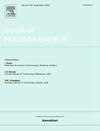Butterfly valve performance factors using the multiphysics object oriented simulation environment
IF 2.3
3区 工程技术
Q1 NUCLEAR SCIENCE & TECHNOLOGY
引用次数: 0
Abstract
Butterfly valves are typically used in nuclear reactors to control incompressible fluid flow with high inlet velocities. Performance factors for butterfly valves include the pressure drop across the valve and the loss coefficient from which hydrodynamic torque and flow coefficients can be computed. This work explores a computational fluid dynamics approach for butterfly valve performance factors using the open-source Multiphysics Object Oriented Simulation Environment (MOOSE) framework. While MOOSE is often used in the nuclear energy modeling and simulation community for simulations ranging from fuel characterization to heat pipe simulation, this work employs the MOOSE open-source Navier–Stokes solver capability for simulating butterfly valve performance factors and compares those to experimentally measured results from the Advanced Test Reactor at Idaho National Laboratory at Reynolds numbers in the order of for the partially opened configuration. The MOOSE framework results are compared against experimentally measured butterfly valve performance factors across five valve opening angles using meshes with order – elements. This validation serves to enable MOOSE-based multiphysics simulations incorporating the open-source Navier–Stokes module.
蝶阀性能因素采用面向多物理场对象的仿真环境
蝶阀通常用于核反应堆中,以控制具有高入口速度的不可压缩流体流动。蝶阀的性能因素包括阀上的压降和损失系数,由此可以计算流体动力扭矩和流量系数。本研究利用开源的多物理场面向对象仿真环境(MOOSE)框架,探索了蝶阀性能因素的计算流体动力学方法。虽然MOOSE经常用于核能建模和模拟社区,用于从燃料特性到热管模拟的模拟,但这项工作使用MOOSE开源的Navier-Stokes解算器功能来模拟蝶阀性能因素,并将其与爱达荷国家实验室先进试验堆的实验测量结果进行比较,在部分打开的配置下,雷诺数为106。MOOSE框架的结果与实验测量的蝶阀性能因素进行了比较,这些因素采用了104 - 105阶的网格,跨越5个阀门开度角。该验证有助于实现基于moose的多物理场模拟,并结合开源的Navier-Stokes模块。
本文章由计算机程序翻译,如有差异,请以英文原文为准。
求助全文
约1分钟内获得全文
求助全文
来源期刊

Annals of Nuclear Energy
工程技术-核科学技术
CiteScore
4.30
自引率
21.10%
发文量
632
审稿时长
7.3 months
期刊介绍:
Annals of Nuclear Energy provides an international medium for the communication of original research, ideas and developments in all areas of the field of nuclear energy science and technology. Its scope embraces nuclear fuel reserves, fuel cycles and cost, materials, processing, system and component technology (fission only), design and optimization, direct conversion of nuclear energy sources, environmental control, reactor physics, heat transfer and fluid dynamics, structural analysis, fuel management, future developments, nuclear fuel and safety, nuclear aerosol, neutron physics, computer technology (both software and hardware), risk assessment, radioactive waste disposal and reactor thermal hydraulics. Papers submitted to Annals need to demonstrate a clear link to nuclear power generation/nuclear engineering. Papers which deal with pure nuclear physics, pure health physics, imaging, or attenuation and shielding properties of concretes and various geological materials are not within the scope of the journal. Also, papers that deal with policy or economics are not within the scope of the journal.
 求助内容:
求助内容: 应助结果提醒方式:
应助结果提醒方式:


